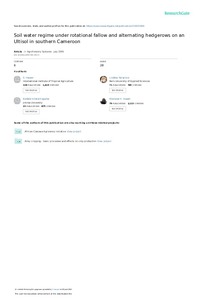| dc.contributor.author | Hauser, S. |
| dc.contributor.author | Norgrove, L. |
| dc.contributor.author | Duguma, B. |
| dc.contributor.author | Asaah, E. |
| dc.date.accessioned | 2019-12-04T11:23:41Z |
| dc.date.available | 2019-12-04T11:23:41Z |
| dc.date.issued | 2005-07 |
| dc.identifier.citation | Hauser, S., Norgrove, L., Duguma, B. & Asaah, E. (2005). Soil water regime under rotational fallow and alternating hedgerows on an Ultisol in southern Cameroon. Agroforestry Systems, 64(1), 73-82. |
| dc.identifier.issn | 0167-4366 |
| dc.identifier.uri | https://hdl.handle.net/20.500.12478/4105 |
| dc.description | Article purchased |
| dc.description.abstract | Soil moisture depletion during dry seasons by planted hedgerows to lower levels than under natural fallow, would reduce drainage and nutrient losses in the following rainy season when food crops are grown. The volumetric water content of the 0–150 cm soil profile was measured under planted hedgerows (alternating Leucaena leucocephala and Gliricidia sepium) and natural fallow, both either annually cropped to sole maize or in a two-year crop/two-year fallow rotation, in the humid forest zone (annual rainfall 1700 mm) of southern Cameroon during the 1995–1996 and 1996–1997 dry seasons. Hedgerows were cut to 0.05 m height, largely eliminating trees’ water consumption during cropping phases. Differences in total soil water content at 0–150 cm depth, between systems, occurred only in the early phases of the 1996–1997 dry season. In both dry seasons, differences between systems in water content were found in some soil layers, all within 0–60 cm depth, yet, without consistent advantage of any system in exploiting the topsoil water resources. Soil water content was lower under L. leucocephala than G. sepium at 20–40 cm depth only. Below 60 cm depth, no differences in water regimes between systems were found. Under southern Cameroonian conditions it is unlikely that any of the systems has an advantage in accessing or recovering water and thus, if available, nutrients from the sub-soil. None of the systems examined was capable of delaying drainage and thus it appears unlikely that downward displacement of nutrients is delayed after the start of the rains. |
| dc.format.extent | 73-82 |
| dc.language.iso | en |
| dc.subject | Alley Cropping |
| dc.subject | Gliricidia Sepium |
| dc.subject | Leucaena Leucocephala |
| dc.subject | Fallow |
| dc.subject | Nutrient Cycling |
| dc.subject | Soil |
| dc.title | Soil water regime under rotational fallow and alternating hedgerows on an Ultisol in southern Cameroon |
| dc.type | Journal Article |
| dc.description.version | Peer Review |
| cg.contributor.crp | Roots, Tubers and Bananas |
| cg.contributor.affiliation | International Institute of Tropical Agriculture |
| cg.contributor.affiliation | International Center for Research in Agroforestry |
| cg.contributor.affiliation | Kings College London |
| cg.coverage.region | Africa |
| cg.coverage.region | Central Africa |
| cg.coverage.country | Cameroon |
| cg.creator.identifier | Stefan Hauser: 0000-0002-6329-7783 |
| cg.isijournal | ISI Journal |
| cg.authorship.types | CGIAR and advanced research institute |
| cg.iitasubject | Natural Resource Management |
| cg.iitasubject | Soil Information |
| cg.journal | Agroforestry Systems |
| cg.howpublished | Formally Published |
| cg.accessibilitystatus | Open Access |
| local.dspaceid | 99538 |
| cg.targetaudience | Scientists |
| cg.identifier.doi | https://dx.doi.org/10.1007/s10457-005-2442-0 |

